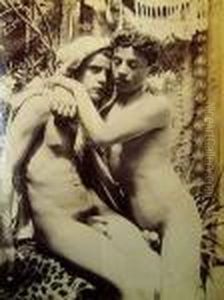Guillaume, Guglielmo Pluschow Paintings
Wilhelm (Guglielmo) Pluschow, more commonly known as Wilhelm von Plüschow or under the Italianized version of his name, Guglielmo Plüschow, was a German photographer who gained renown for his nude studies of Italian youths. Born in Wismar, then part of the Grand Duchy of Mecklenburg-Schwerin (now in Germany), in 1852, Plüschow was a cousin of the more famous photographer Wilhelm von Gloeden, who worked in Taormina, Sicily. The two are often associated with each other due to their similar subject matter and the fact that they were both pioneers in the field of male nude photography during the late 19th and early 20th centuries. Plüschow's work, however, is distinguished by its setting and composition, reflecting his own unique artistic vision.
Plüschow initially embarked on his photographic career in Rome, where he moved in the early 1870s. His studio became a center for the artistic community, attracting a number of notable visitors and patrons from across Europe. Plüschow's photographs are celebrated for their classical beauty, composition, and the natural ease of his models. Unlike von Gloeden, who often used Sicilian peasants as models, Plüschow worked with a more diverse group of models, including those from Rome and Naples, which added a different dimension to his work. His photographs often featured the nude or semi-nude male form, set against the backdrop of the Italian landscape or classical ruins, creating a blend of natural beauty and ancient history.
In 1902, Plüschow's career faced a significant setback when he was arrested on charges related to homosexuality, which was illegal at the time, and the creation of indecent images. After serving a brief prison sentence, he was expelled from Italy and moved to Berlin. Despite this, he continued his photographic work, though his later years were marked by financial difficulties and a decline in his reputation. Plüschow's artistic legacy, however, has been reassessed and celebrated in recent decades for its contribution to the art of photography and its historical value in documenting male beauty and homoerotic aesthetics at a time when such subjects were considered taboo.
Guglielmo Plüschow died in 1930 in Berlin, Germany. His body of work remains a significant part of the history of photography, not only for its artistic quality but also for its bold exploration of themes related to beauty, sexuality, and the male form. Today, Plüschow's photographs are collected and exhibited in art galleries and museums around the world, recognized for their historical importance as well as their aesthetic and cultural significance.
